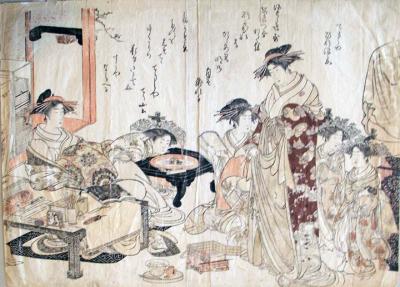This is one in a series of woodblock prints offering the Japanese public a look at the leading prostitutes of the Yoshiwara (pleasure district). Along the top of each sheet is a waka (thirty-one-syllable) poem written in the women’s own hand to show her abilities in calligraphy. Handwriting was only one of the many attributes expected from a high-class courtesan at that time.
The artist Kitao Masanobu was only twenty-two when he produced what would become his most famous work, Seirō meikun jihitsu-shū (Collection of calligraphy by celebrated Yoshiwara courtesans). The seven double ōban woodblock prints each depict two bijin or beauties along with their kamuro (eight to twelve year old attendants learning the business).
According to Cecilia Seigle’s book Yoshiwara (Firestone HN730.T65 S45 1993), Masanobu practically lived in the pleasure district during the 1780s and may have drawn these images from life. The following year, the artist teamed up with publisher Tsutaya Jūsaburō to reformat the series into a book, newly titled Shin Bijin Awase Jihitsu Kagami.
In this sheet, Hinazuru is on the right, showing her New Year kimonos. Chōzan is seated on the left at a writing desk. She has a calligraphy primer, a copy of the book Eiga monogatari (Tales of Glory), and strips of paper waiting for her to write New Years poems.
